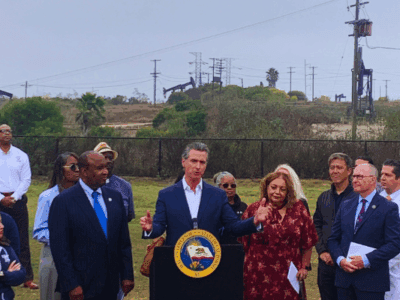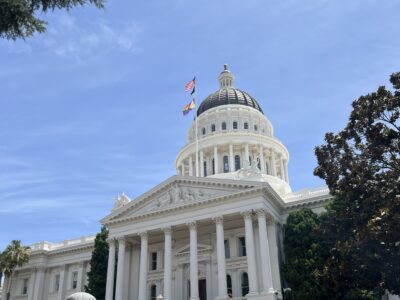California environmental justice advocates sue Air Resources Board over climate scoping plan
UPDATES:- California Air Resources Board Chair (and former UCLA colleague) Mary Nichols comments below.
- The Complaint in this action is available here (caption page separately available here).
A coalition of California environmental justice advocates has filed a lawsuit challenging the legality of the California Air Resources Board‘s scoping plan for AB 32, the landmark climate change law enacted in 2006. The plaintiffs include Communities for a Better Environment, the Center on Race, Poverty, and the Environment (whose visionary executive director Luke Cole tragically passed away last week), and California Communities Against Toxics.
Under AB 32, the ARB is tasked with developing and implementing regulations that will dramatically reduce the state’s emissions of greenhouse gases over the coming years. The scoping plan, which the ARB was required to develop under AB 32, sets forth the blueprint for those regulations, which will be developed over the next 18 months and finalized by the end of 2010.
The scoping plan relies heavily on a market-based “cap-and-trade” system, which would require major greenhouse gas emitters to obtain “allowances” permitting them to emit greenhouse gases. (The Waxman-Markey proposed federal legislation would rely on this same type of mechanism: see links from my previous post for more details.) The allowance holders could then buy, sell, or trade these allowances among themselves in order to reallocate the right to emit GHGs. The total quantity of GHG emissions allowed by the allowances, or the “cap,” would be set at a level low enough to require overall reductions in GHG emissions, and the cap would be reset at a lower level each year.
Poor and minority communities suffer disproportionate harms from environmental problems (both human- and non-human-created). They have significantly more industrial pollution than other communities, resulting, among other impacts, in a higher cancer burden, and have access to fewer resources to address the problems. At the same time, these communities will bear a disproportionate risk from climate change’s impacts, such as hotter urban areas and exacerbation of air quality problems.
U.S. environmental justice advocacy groups, which champion the rights of poor communities and communities of color to be free from disproportionate environmental and public health harms, generally oppose cap-and-trade for several reasons. First, they believe that it is likely that allowances to emit greenhouse gases will be overallocated and the market will be “gamed” by corporate interests, yielding little or no benefit from greenhouse gas reductions. Second, to the extent that allowances are given away rather than auctioned, they argue, corporations will make windfall profits from the free allowances. Finally, they believe that such a system will inevitably result in higher levels of traditional pollutants in “hot spots” in poor communities. They note that polluting facilities in those communities are likely to be able to maintain high levels of operation by obtaining allowances giving them the right to emit greenhouse gases, and they argue that our existing regulatory structure will be inadequate to deal with the co-pollutants generated by these facilities. (These and other reasons are summarized in this document.)
Proponents of cap-and-trade, a group that includes many environmental advocacy organizations such as NRDC (which now calls the system “cap and invest”) and EDF, many business interests, some economists and other researchers, and of course the California Air Resources Board, argue that none of these problems is inherent in a cap-and-trade system. They contend that a properly designed cap-and-trade program can reduce GHG emissions while avoiding all these problems.
The environmental justice community is widely thought of as being a key player in shaping AB 32’s language to state that market-based greenhouse gas control mechanisms such as cap-and-trade “may” be used, rather than to require the use of market-based tools. But shortly after the legislation was passed, Governor Schwarzenegger issued an executive order that made clear that he intended for ARB to pursue market-based regulation of GHGs, angering the environmental justice community. Thus, their opposition to the ARB’s scoping plan, which relies heavily on a cap-and-trade program to meet its goals, is not surprising.
I have not yet obtained a copy of the complaint. But according to the plaintiffs’ media materials, the lawsuit alleges that the ARB violated both the California Environmental Quality Act and AB32 itself in its approval of the scoping plan.
It will be interesting to see reactions to this lawsuit, and to watch it work its way through the courts in the coming months.
Reader Comments
4 Replies to “California environmental justice advocates sue Air Resources Board over climate scoping plan”
Comments are closed.







ARB has not yet seen the complaint, but we are confident that we have complied with the letter and the spirit of AB32. Our process for developing the Scoping Plan was unprecedented in its openness and transparency, including many opportunities for substantive comment and interaction as the plan went through the draft process and through the final adoption. Ironically, some of the plaintiffs sit on ARB’s Environmental Justice Advisory Committee (created by AB32) and enjoyed unparalleled access to ARB staff and board members throughout plan preparation.
As to the underlying concerns about cap and trade, we are in the early stages of developing a proposal that is expected to be brought to the Board for adoption in late 2010. Now is the time to begin focusing on mechanisms to assure that the program is designed to assure that the communities that are most negatively impacted by industrial pollution receive a proportionately greater share of the benefits, including direct co-benefits from cleanup of existing sources.
I know this is a sensitive subject, but I think many readers would really like to hear what our various professor-bloggers think of the suit. Are any claims easily dismissed or particularly troublesome for ARB? Will it delay implementation? What would a possible settlement look like?
I’d try to delve into this more myself, but I’m: a) no expert and b) supposed to be memorizing Wills & Trusts.
Jon, I still haven’t gotten a chance to examine these claims thoroughly. I may follow up with another post. As for possible settlement: I suspect that the environmental justice community and ARB have both dug in their heels on this one, so it’s hard for me to envision what a resolution would look like. But I could be wrong.
Any word on EDF’s motion to intervene in the case or the role they might play?